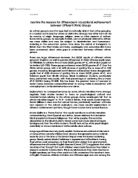Examine the reasons for changes in the patterns of marriage, cohabitation and divorce in the last 30 years.
E) Examine the reasons for changes in the patterns of marriage, cohabitation and divorce in the last 30 years.
Britain today is a much more complex society than in past times, with great diversity in terms of households within which people live. Much of this diversity has been gained at the expense of tradition and there has been a downward trend in the certain types of families. Despite some improvements in recent years in incomes in gender opportunities, equality was neglected much more during post war times. Sociologists argue that the changes to more lenient and less traditional attitudes are responsible for the recent changes in marital behaviour. In recent decades, marriage rates have fallen, divorce rates have risen, and the defining characteristics of marriage have changed.
Over the last 30 years, one of the most profound social changes in industrial societies has been the decline in marriage, cohabitation and divorce rates. Families have changed in the last several decades. Instead of getting married, many people are living together or cohabiting. Some of these cohabitating couples eventually get married. Many of them break up. Very few stay together as cohabitants for long. The decline in marriage has been parallel with the rise in non marital cohabitation. In the mid-1960s, only five per cent of single women lived with a man before getting married, by the 1990s, about 70 per cent did. Some people think that living together will lead automatically to marriage, but that is not often the case. For many other couples, cohabitation is viewed as an alternative to marriage rather than a preparation for it. However, this alternative is less likely than marriage to lead to a long-term stable commitment. Cohabiting relationships are fragile. They are always more likely to break up than marriages.







